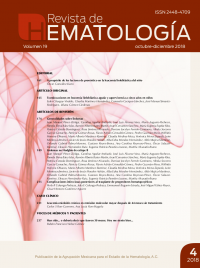Generalities about lymphomas.
Rev Hematol Mex. 2018 octubre-diciembre;19(4):174-188.
Juan Manuel Pérez-Zúñiga,1 Carolina Aguilar-Andrade,2 José Luis Álvarez-Vera,2 María Augusto-Pacheco,2 Pamela Elena Báez-Islas,2 Ramón Alberto Bates-Martín,2 Israel Cervantes-Sánchez,2 María Eugenia Espitia-Ríos,2 Patricia Estrada-Domínguez,2 Rosa Jiménez-Alvarado,2 Denisse Jocelyn Fermín-Caminero,2 Alinka Socorro García-Camacho,2 Patricia Gómez-Rosas,2 Flavio Adrián Grimaldo-Gómez,3 Pedro Guzmán-Mera,2 Wilfrido Herrera-Olivares,4 Mario Alberto Martínez-Ramírez,5 Claudia Medina-Meza,6Verónica Mena-Zepeda,2 Leire Montoya-Jiménez,2 Javier de Jesús Morales-Adrián,7 Alba Edna Morales-Hernández,8 Aldo Mujica-Martínez,2 Orlando Gabriel Palma-Moreno,9 Gustavo Reyes-Brena,10 Ana Carolina Reynoso-Pérez,2 Óscar Salazar-Ramírez,11Eleazar Hernández-Ruiz,12 Eugenia Patricia Paredes-Lozano,13 Martha Alvarado-Ibarra2
1 Hospital Regional General Ignacio Zaragoza, ISSSTE, Ciudad de México.
2 Centro Médico Nacional 20 de Noviembre, ISSSTE, Ciudad de México.
3 Instituto Nacional de Cardiología, Ciudad de México.
4 Hospital Regional Puebla, Puebla, México.
5 Hospital Regional de Alta Especialidad, Veracruz, Veracruz, México.
6 Hospital H+, Querétaro, México.
7 Hospital Regional ISSSTE, Mérida, Yucatán, México.
8 Hospital Ángeles Clínica Londres, Ciudad de México.
9 Hospital General de Especialidades Dr. Javier Buenfil Osorio, Campeche, México.
10 Hospital del ISSSTE de León, Guanajuato, México.
11 Hospital General Dr. Dario Fernández Fierro, ISSSTE, Ciudad de México.
12 Hospital Presidente Juárez, ISSSTE, Oaxaca, Oaxaca, México.
13 Hospital Regional 1° de Octubre, ISSSTE, Ciudad de México.
Resumen
El cáncer se ha incrementado en los últimos años, los linfomas no Hodgkin representan en México la segunda causa de neoplasias hematológicas; asimismo, se cuenta con métodos de estadificación de enfermedad, riesgo y aproximación a perfiles de expresión génica por inmunohistoquímica que tienen importantes implicaciones de diagnóstico, pronóstico y de tratamiento. A través del tiempo, se han perfeccionado los diversos instrumentos diagnósticos, equipos y técnicas, lo que permite la optimización de los resultados al establecer medidas terapéuticas tras subclasificar los linfomas por estirpe histológica, fenotipo B o T, grado de maduración, índice de replicación, así como características moleculares e incluso algoritmos de diferenciación. Una vez definida la variedad y subtipo de linfoma, existen otros retos para el clínico, entre los que se encuentran los sitios implicados, para obtener las diversas etapas clínicas independientemente de la clasificación utilizada. Asimismo, existen diversas clasificaciones de pronóstico de la enfermedad, que permiten optimizar los resultados finales y predecir los posibles desenlaces en supervivencia en este grupo de pacientes. Este documento busca resumir las características generales a considerar en los pacientes con linfoma no Hodgkin previo al inicio del tratamiento; sin embargo, debe recordarse que los avances en esta área pueden generar controversias con esta revisión y debe imperar el razonamiento clínico y la medicina basada en evidencia a favor del beneficio clínico de los enfermos.
PALABRAS CLAVE: Linfoma no Hodgkin; neoplasias hematológicas; inmunohistoquímica.
Abstract
Nowadays, cancer have increased; non-Hodgkin lymphomas in Mexico represent the second cause of hematological malignancies, in addition, there are methods of staging the disease, risk and an approach to gene expression profiles by immunohistochemistry that have important implications in diagnosis, prognosis and treatment. Over time, the diagnostic instruments, equipment and techniques have been perfected, which allows the optimization of the results to establish the basic measures to subclassify the lymphomas by histological strain, phenotype B or T, degree of maturation, replication index as well as molecular characteristics and even differentiation algorithms. Once the variety and subtype of lymphoma are defined, there are other issues for the clinician, among which are the sites involved and with these sites, the optimal classification system, whatever it is, which allows optimizing the final results and predicting the possible outcomes in survival is this group of patients. The target of this document is to summarize the general characteristics to be considered in patients with non-Hodgkin lymphoma at the beginning of treatment; however, it should be remembered that advances in this medical area may generate controversies with this review and must dominate clinical reasoning and the medicine based on evidence in favor of the clinical benefit of the patients.
KEYWORDS: Non-Hodgkin lymphomas; Hematological malignancies; Immunohistochemistry.

